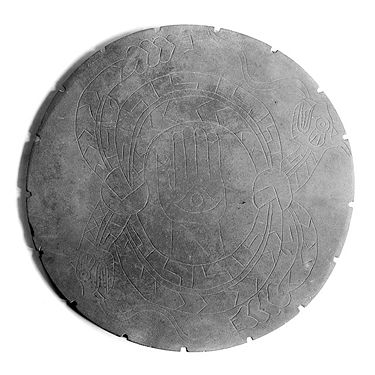Rattlesnake Disc: Difference between revisions
(stub) |
No edit summary |
||
| Line 1: | Line 1: | ||
[[Image:Rattlesnake Disc.jpg|right|375px]] | [[Image:Rattlesnake Disc.jpg|right|375px]] | ||
The '''Rattlesnake Disc''' or '''Serpent Disc''' is an artifact of the prehistoric Mississippian-age [[Moundville culture]]. The round sandstone carving, approximately 12 inches in diameter, was probably created between [[ | The '''Rattlesnake Disc''' or '''Serpent Disc''' is an artifact of the prehistoric Mississippian-age [[Moundville culture]]. The round sandstone carving, approximately 12 inches in diameter, was probably created between [[1300]] and [[1450]]. It was found in the 19th century near the site of the present [[Moundville Archeological Park]] by a farmer who gave it to state geologist [[Eugene Allen Smith]]. It is currently housed at the [[Jones Archaeological Museum]], operated by the [[University of Alabama Museums]] at Moundville. | ||
The incised decoration on the front of the disc shows two horned rattlesnakes knotted together to form a circle around a hand with an eye on its palm. The reverse has three concentric circles near the outer edge. The rim of the disc has 17 small notches, evenly spaced. Such discs are sometimes called "palettes" because they are found with traces of paint pigments. It is not known whether they were decorated with paint, or used as a surface for mixing pigments. | |||
==References== | |||
* Moore, Clarence Bloomfield (1905) ''Certain Aboriginal Remains of the Black Warrior River''. ''Journal of the Academy of Natural Sciences of Philadelphia''. Vol. 13, pp. 125–244 | |||
* Moore, Clarence Bloomfield (1907) ''Moundville Revisited''. ''Journal of the Academy of Natural Sciences of Philadelphia''. Vol. 13, pp. 337–405 | |||
[[Category:Prehistoric works]] | [[Category:Prehistoric works]] | ||
[[Category:Sculpture]] | [[Category:Sculpture]] | ||
[[Category:Moundville]] | [[Category:Moundville]] | ||
Revision as of 23:56, 28 February 2011
The Rattlesnake Disc or Serpent Disc is an artifact of the prehistoric Mississippian-age Moundville culture. The round sandstone carving, approximately 12 inches in diameter, was probably created between 1300 and 1450. It was found in the 19th century near the site of the present Moundville Archeological Park by a farmer who gave it to state geologist Eugene Allen Smith. It is currently housed at the Jones Archaeological Museum, operated by the University of Alabama Museums at Moundville.
The incised decoration on the front of the disc shows two horned rattlesnakes knotted together to form a circle around a hand with an eye on its palm. The reverse has three concentric circles near the outer edge. The rim of the disc has 17 small notches, evenly spaced. Such discs are sometimes called "palettes" because they are found with traces of paint pigments. It is not known whether they were decorated with paint, or used as a surface for mixing pigments.
References
- Moore, Clarence Bloomfield (1905) Certain Aboriginal Remains of the Black Warrior River. Journal of the Academy of Natural Sciences of Philadelphia. Vol. 13, pp. 125–244
- Moore, Clarence Bloomfield (1907) Moundville Revisited. Journal of the Academy of Natural Sciences of Philadelphia. Vol. 13, pp. 337–405
